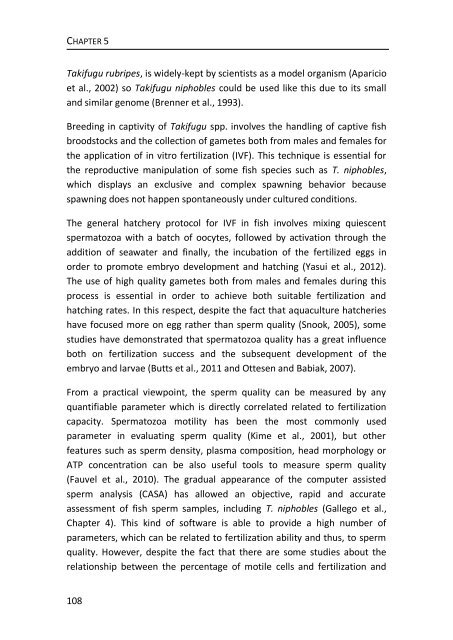chapter 3 - RiuNet
chapter 3 - RiuNet
chapter 3 - RiuNet
Create successful ePaper yourself
Turn your PDF publications into a flip-book with our unique Google optimized e-Paper software.
CHAPTER 5<br />
Takifugu rubripes, is widely-kept by scientists as a model organism (Aparicio<br />
et al., 2002) so Takifugu niphobles could be used like this due to its small<br />
and similar genome (Brenner et al., 1993).<br />
Breeding in captivity of Takifugu spp. involves the handling of captive fish<br />
broodstocks and the collection of gametes both from males and females for<br />
the application of in vitro fertilization (IVF). This technique is essential for<br />
the reproductive manipulation of some fish species such as T. niphobles,<br />
which displays an exclusive and complex spawning behavior because<br />
spawning does not happen spontaneously under cultured conditions.<br />
The general hatchery protocol for IVF in fish involves mixing quiescent<br />
spermatozoa with a batch of oocytes, followed by activation through the<br />
addition of seawater and finally, the incubation of the fertilized eggs in<br />
order to promote embryo development and hatching (Yasui et al., 2012).<br />
The use of high quality gametes both from males and females during this<br />
process is essential in order to achieve both suitable fertilization and<br />
hatching rates. In this respect, despite the fact that aquaculture hatcheries<br />
have focused more on egg rather than sperm quality (Snook, 2005), some<br />
studies have demonstrated that spermatozoa quality has a great influence<br />
both on fertilization success and the subsequent development of the<br />
embryo and larvae (Butts et al., 2011 and Ottesen and Babiak, 2007).<br />
From a practical viewpoint, the sperm quality can be measured by any<br />
quantifiable parameter which is directly correlated related to fertilization<br />
capacity. Spermatozoa motility has been the most commonly used<br />
parameter in evaluating sperm quality (Kime et al., 2001), but other<br />
features such as sperm density, plasma composition, head morphology or<br />
ATP concentration can be also useful tools to measure sperm quality<br />
(Fauvel et al., 2010). The gradual appearance of the computer assisted<br />
sperm analysis (CASA) has allowed an objective, rapid and accurate<br />
assessment of fish sperm samples, including T. niphobles (Gallego et al.,<br />
Chapter 4). This kind of software is able to provide a high number of<br />
parameters, which can be related to fertilization ability and thus, to sperm<br />
quality. However, despite the fact that there are some studies about the<br />
relationship between the percentage of motile cells and fertilization and<br />
108
















